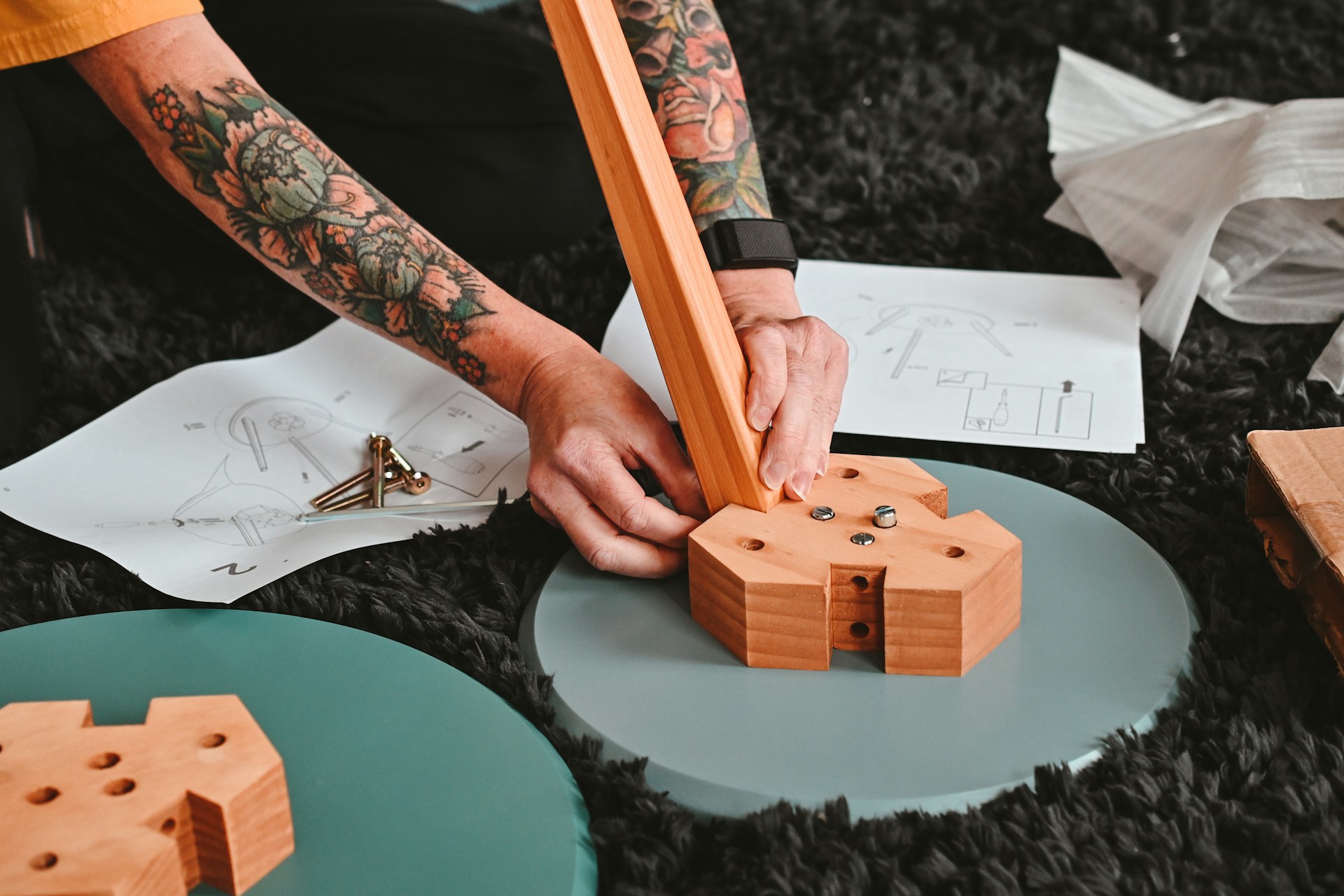Have you ever admired a beautifully painted room in a magazine and dreamt of achieving the same transformation in your own space? Or perhaps envisioned sprucing up your patio furniture for a fresh summer vibe? The world of DIY (Do-It-Yourself) home improvement might seem intimidating at first, but fear not! This blog post is your roadmap to unlocking the satisfaction and empowerment of tackling beginner-friendly projects that transform your living space.
Know the DIY Spirit: Dispelling the Beginner’s Hesitation
The desire to personalize your home and create a space that reflects your style is a common aspiration. However, some beginners might hesitate to embark on DIY projects due to perceived difficulty or lack of prior experience. Let us assure you – many home improvement tasks are surprisingly accessible, requiring only basic tools and a willingness to learn.
The Rewards of DIY: Beyond Just Savings
There’s a unique sense of accomplishment that comes from transforming your living space through DIY projects. Here are some reasons to consider embracing your inner DIY master:
a. Cost Savings:
By tackling projects yourself, you can potentially save money compared to hiring a professional.
b. Customization and Control:
DIY projects allow you to personalize your space exactly how you envision it, choosing materials and finishes that reflect your taste.
c. A Sense of Achievement:
Completing a project, big or small, instills a sense of pride and accomplishment, boosting your confidence for future endeavors.
Choosing the Right DIY Project: Finding Your Perfect Fit
Not all DIY projects are created equal. The key is to select a task that aligns with your skill level, budget, and desired outcome. Here are some factors to consider:
a. Skill Level:
Be honest about your experience. Start with simpler projects and gradually progress to more complex tasks as your confidence grows.
b. Time Commitment:
Consider the time investment required for each project. Choose something that fits comfortably within your schedule.
c. Budget:
Set a realistic budget for your project, factoring in the cost of tools, materials, and any potential unforeseen expenses.
d. Desired Outcome:
What do you hope to achieve? Do you want to refresh a room’s look, improve functionality, or add a personal touch?
Safety First: A Top Priority for Successful DIY
Safety is paramount when undertaking any DIY project. Before starting, ensure you understand the necessary safety precautions. Here are some general tips:
Read Instructions Carefully:
Always read and understand the instructions for tools and materials before using them.
Wear Proper Safety Gear:
Depending on the project, this might include gloves, eye protection, dust masks, or ear protection.
Work in a Well-Ventilated Area:
Some materials emit fumes, so ensure proper ventilation when working with paints, adhesives, or anything with a strong odor.
Know When to Seek Help:
Don’t hesitate to seek guidance from experienced DIYers or professionals for more complex tasks that might require specialized knowledge or equipment.
Building Your DIY Arsenal: Essential Tools & Materials
Every successful DIYer relies on a core set of tools. Here’s a breakdown of some essential items for beginners:
a. The Mighty Hammer:
A sturdy claw hammer is a versatile tool for driving nails, prying boards, and tackling various demolition tasks.
b. The Indispensable Screwdriver Set:
Invest in a set of screwdrivers with flathead and Phillips heads to tackle a variety of screws encountered in furniture assembly, cabinet repairs, and other projects.
c. The All-Seeing Tape Measure:
A reliable tape measure is crucial for accurate measurements when cutting materials, planning furniture placement, and ensuring a perfect fit for your projects.
d. The Level-Headed Level:
A torpedo level ensures surfaces are perfectly horizontal or vertical, critical for hanging shelves, installing cabinets, and ensuring straight lines in your paint jobs.
e. The Cutting Companion:
A utility knife with replaceable blades is ideal for cutting through cardboard, rope, tape, and other materials encountered in various projects.
e. The Safety Essentials:
Safety glasses, work gloves, a dust mask, and hearing protection are essential investments for protecting yourself from dust, debris, and potential injuries.
Material Selection: Choosing Quality for Lasting Results
Beyond tools, the quality of your materials directly impacts the outcome of your projects. Here are some tips for choosing the right materials:
a. Read Project Requirements:
Project instructions often specify the type and quantity of materials needed.
b. Consider Quality vs. Cost:
While budget is a factor, opting for higher-quality materials can lead to a more durable and aesthetically pleasing end result.
c. Ask for Help at Hardware Stores:
Don’t hesitate to seek assistance from knowledgeable staff at hardware stores. They can guide you towards the appropriate materials based on your project and skill level.
Staying Organized: A Recipe for DIY Success
Preparation is key for a smooth and efficient DIY experience. Here’s how to stay organized throughout your project:
Gather Your Tools and Materials:
Assemble everything you need before starting to avoid frustrating delays during the project.
Clear Your Workspace:
Create a dedicated workspace for your project, ensuring ample space for tools, materials, and maneuvering comfortably.
Label Everything:
Clearly label containers of paint, screws, or any other materials to avoid confusion during the project.
Follow a Step-by-Step Approach:
Break down the project into manageable steps and follow the instructions carefully, ensuring you don’t miss any crucial details.
Now that you’re equipped with the essential knowledge and tools, let’s dive into the exciting world of beginner-friendly DIY projects!
Easy DIY Projects for Beginners:
Here’s a curated selection of DIY projects that are perfect for beginners, allowing you to transform your space with a sense of accomplishment:
1. Breathe New Life into Your Walls: The Power of Paint
A fresh coat of paint can dramatically alter the look and feel of any room. Here’s how to achieve a flawless paint job:
a. Surface Preparation is Key:
Begin by removing any existing wall hangings, switchplate covers, and outlet covers. Wash the walls with a damp cloth to remove dust and cobwebs. Address any minor cracks or holes with spackle and allow it to dry completely before sanding smooth.
b. Choosing the Perfect Paint:
Select a paint suitable for your desired finish (matte, eggshell, satin) and consider the room’s functionality (high-moisture areas like bathrooms might require special paint). Opt for a quality paint as it offers better coverage and durability.
c. Painting Like a Pro:
Cover your floors and furniture with drop cloths. Use painter’s tape to create clean lines around trim, baseboards, and ceilings. Apply a primer coat for better paint adhesion, especially if you’re painting over a dark color. Once dry, apply two thin coats of your chosen paint color, allowing for drying time between coats.
d. Pro Tip:
Invest in a paintbrush for edging and tight corners, and use a roller for covering larger wall surfaces efficiently.
2. Simple Plumbing Fixes: Conquering Common Issues
Don’t let leaky faucets or a malfunctioning showerhead dampen your spirits! Here are some beginner-friendly plumbing fixes:
The Leaky Faucet:
Identify the source of the leak – it could be a worn-out washer or a faulty cartridge. Most hardware stores sell faucet repair kits containing replacement parts for various models. Turn off the water supply beneath the sink, disassemble the faucet handle, replace the worn-out parts, and reassemble, ensuring a secure fit. Tighten any loose connections to prevent future leaks.
Showerhead Spruce-Up:
Over time, mineral buildup can clog your showerhead, reducing water pressure and spray functionality. Most showerheads can be easily unscrewed with a wrench. Soak the showerhead in a vinegar solution to dissolve mineral deposits. Scrub any remaining buildup with a toothbrush and rinse thoroughly. Reattach the showerhead and enjoy a revitalized shower experience.
3. Light Up Your Life: Replacing Light Fixtures
Replacing outdated light fixtures is a quick and easy way to modernize the look of any room. Here’s a breakdown of the process:
Safety First:
Always turn off the power supply to the circuit controlling the light fixture you’re replacing. Use a voltage tester to ensure the circuit is off before proceeding.
Match the Wiring:
Carefully remove the old light fixture, noting the wire connections. When installing the new fixture, match the corresponding wire colors (black to black, white to white, and ground wire to the ground screw). Tighten all wire connections securely using wire nuts.
Secure the Fixture:
Attach the new light fixture to the mounting bracket using the provided screws. Reconnect the power supply and test the functionality of your new light fixture.
4. Hardware Refresh: Update Your Cabinet Knobs and Pulls
Cabinet hardware plays a surprisingly significant role in the overall aesthetic of your kitchen or bathroom. Here’s how to update your cabinet hardware for a fresh look:
Measure and Match:
Measure the center-to-center hole spacing on your existing cabinet hardware. This measurement is crucial for selecting replacement hardware that aligns perfectly with the existing screw holes.
Unscrew and Replace:
Using a screwdriver, remove the existing knobs or pulls. Line up the new hardware with the screw holes and secure them tightly using the provided screws.
Explore Your Options:
Hardware stores offer a wide variety of cabinet hardware options in different styles, finishes, and materials. Choose something that complements the overall design of your kitchen or bathroom.
5. Decorative Touches: Spruce Up Your Space on a Budget
While larger projects can transform a space, don’t underestimate the power of small decorative touches. Here are some budget-friendly DIY ideas to personalize your home:
Gallery Wall Magic:
Turn a blank wall into a conversation starter by creating a gallery wall. Collect artwork, photographs, or even postcards that reflect your style. Arrange them on the floor to visualize the layout before hanging them on the wall.
Picture Perfect Shelves:
Install simple floating shelves to display decorative items, books, or small potted plants. Floating shelves come in various lengths and styles, allowing you to customize the look to your space.
DIY Throw Pillows:
Purchase inexpensive throw pillow covers and inject your personality with colorful fabrics or playful patterns. You can even personalize them further with hand-painted designs or stencils.
Patio Furniture Revival:
Don’t let your outdoor furniture succumb to another season of neglect. Reinvigorate metal patio chairs with a fresh coat of rust-resistant paint. Refresh old cushions by recovering them with weatherproof fabric. You can find affordable outdoor fabric options at most fabric stores.
These are just a few examples to spark your creativity. With a little planning and these beginner-friendly projects, you can transform your living space and experience the satisfaction of DIY home improvement.
Tips for Aspiring DIYers
The initial success of your beginner-friendly projects can ignite a passion for DIY endeavors. Here are some tips to keep you motivated and progressing towards more ambitious tasks:
a. Building Confidence:
The initial accomplishment of completing a project is a confidence booster. Embrace the sense of achievement and use it as a springboard to tackle slightly more complex tasks as your skills develop.
b. Research is Key:
Don’t be afraid to delve deeper! The internet is a treasure trove of DIY tutorials, project guides, and resources. Research specific projects you’re interested in and familiarize yourself with the steps involved before diving in.
c. Seek Guidance:
The DIY community is vast and welcoming. Online forums, social media groups, and even local hardware stores often have experienced DIYers willing to offer advice and answer questions.
d. Embrace the Learning Process:
Mistakes are inevitable, especially when starting out. Don’t get discouraged by setbacks. View them as learning experiences and troubleshoot calmly to find solutions.
e. Celebrating Success:
Acknowledge and celebrate your accomplishments, big or small. Share your DIY achievements with friends and family, and take pride in the transformation you’ve created in your living space.
Conclusion:
The world of DIY home improvement is no longer an exclusive domain for seasoned handymen. By embracing the beginner-friendly projects outlined above, you can unlock a sense of empowerment and transform your living space with your own unique touch. Remember, the key is to start small, prioritize safety, and celebrate your achievements.




